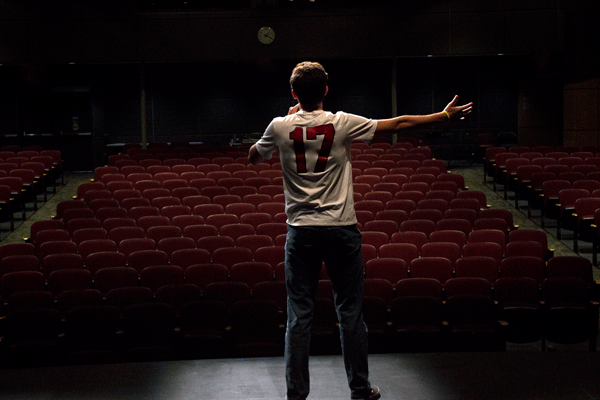True Colors
In a world where fitting in means being “normal,” to these students there isn’t anyone they’d rather be than themselves. For these students, it’s all about showing their…

A jersey doesn’t define who a person is.
The victors write history, but that does not have to be the case. For every winning side there is a losing side as well. So why are the thoughts of the defeated men and women rarely heard? Why don’t people often know how it feels to lose the Superbowl, or go an entire season without ever winning a game? What does it feel like not to consistently dominate, but instead to consistently get dominated? While it is important to know what it’s like to win a game or double an opponent’s score, there are two sides to every story, and the loser’s thoughts and feelings are often overlooked by the winner’s.
The lines dividing groups of students from each other are starting to blur. Common stereotypical social groups, such as jocks, nerds, theatre kids, outcasts and more are beginning to mix. It is becoming more often that you will find someone who may be known to be apart of one group socializing with another. Students can participate in activities that truly spark their interest; because of this, the idea of being “normal” can be forgotten, without sacrificing inclusion.
In order to defy “normal”, it is important to understand what normal is. The normal/average student may be different depending on the specific environment. But at Antioch Community High School, normal is a combination of physical, intellectual and social factors.
“[A normal student] would care about what they looked like and what they wore,” freshman Gigi Stefani said.
According to other students at ACHS, the “normal” student would also wear a combination of nicer outfits and more comfortable outfits, such as khakis and/or sportswear. The student would prioritize school work for the most part and have around a “B” in most of their classes. A “normal” student would also have a decent amount of friends.
Often times, ”normal” is what we see in other people based on previous knowledge, assumed information and rumors. The assumptions we come to when searching for normality can also be known as stereotyping.
Being stereotyped can be felt in positive and negative ways. Sophomore Kaitlyn Bargamian feels the positive effects of being stereotyped. Bargamian describes how being on the cheer team easily places her into the “jock” category. While being stereotyped can be aggravating to some, Bargamian agrees with the placement she has been subconsciously given. Since she is friends with people who are also considered “jocks”, she feels that it justifies her being stereotyped.
On the flipside, stereotyping can be frustrating and unfair.
“We are all the same and we should be treated the same,” junior Jadda Pope said. “When we are in different stereotypes, we are treated differently.”
Pope is also on the cheer team, but she does not always agree with the title she has been given. Pope believes that people should not be treated based on the group they are stereotyped into. By comparing these two examples, the multiple effects of stereotyping are illustrated. However, stereotyping does not only impact athletes, it also impacts the rest of the student body that participate in other activities.
Channin Pluciennik is a sophomore at Antioch Community High School. He, too, feels that he is placed into certain social groups based on the classes he takes and the extracurricular activities he participates in.
“I think I am stereotyped because, for everyone else,” Pluciennik said. “It just makes it easier to categorize individuals, including myself.”
When dealing with the unknown, people may assume something about someone that might not be true at all. According to Pluciennik, this idea can be applied to stereotyping in the high school setting. For example, if a student participates in theatre productions, they will be known as a “theatre kid” even though they may participate in many other activities and be friends with students who do not participate in theatre productions.
The threat of being stereotyped can possibly cause students to be hesitant about participating in activities or joining clubs that truly spark their interest. In Pluciennick’s case, being stereotyped as a “smart” student or a “theatre kid” has not stopped him from playing the sport he enjoys: volleyball. Pluciennik is able to push past any possible prejudice and enjoy the sport that makes him happy.
Nowadays, the constraints of stereotypes are lessening and there is a wider variety of students joining in different clubs and activities. As time went on, students either felt that there was less of a chance of getting judged for participating in an activity, or they may have just stopped caring altogether. Whichever reason it may be, the aftershock of this social breakthrough increased participation and involvement all around.
While many students can relate to the feeling of being categorized or having assumptions made about them, the opposite may not be as common. The converse, described not feeling apart of a group or existing in multiple groups at once, is also prevalent in high schools.
“I don’t feel like I have to hang out with a specific group all the time,” sophomore Holly Horvat said. “I could meet new people and be friends with different people.”
According to Horvat, she is not categorized with a specific group of people. Because of this, she feels that she is free to socialize with anybody she so chooses to without having to worry about fitting a certain stereotype or upsetting a main group of friends. While Horvat may sometimes feel left out because she is not in a stereotypical friend group, she concludes that it is better for her to be able to be friends with people from all types of friend groups.
When being normal is equivalent to being stereotyped, Horvat is the perfect example of not needing to fit into a specific group of friends to still simply have friends. To have a place to fit in, a traditional stereotype is not necessary. Social groups are inevitable by human nature; groups have their purposes, but students should not feel limited to one. Each student possesses their own unique personalities and character traits, so, to say that every student fits into an option on a list of groups could be false. High school is the time to try new things and pursue new fields of interest. With the constraints of stereotypes, students may feel that they are unable to try something new. These feelings can hinder the possibility of a new passion or even a possible occupation.
Being stereotyped and not being stereotyped each have their pros and cons. Whether it has a positive or negative connotation often depends on the individual. But is there a generic answer that provides the best situation for all? Is there a happy medium between being stereotyped and not being in a group at all?
When it comes to fitting in, the social structure of high school consists of many groups tailored to specific individual characteristics. These groups on their own give students many selections of groups to socialize with, and each of these groups has their own perception of normal. The concept of normal is twisted and contorted to each group, and each specific person. There are many ideas of what “normal” should look like; there is no singular answer. Being “normal” is a concept that is commonly heard, but rarely understood. One perception of normal does not always have to criticize another perception of normal. Each is unique and individual in itself.
Whatever path a student decides to go down in high school, normality is not required. High school is the time to branch out and try new things. While doing this, it is most important that they feed their soul, not their ego.



